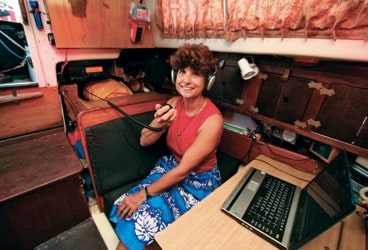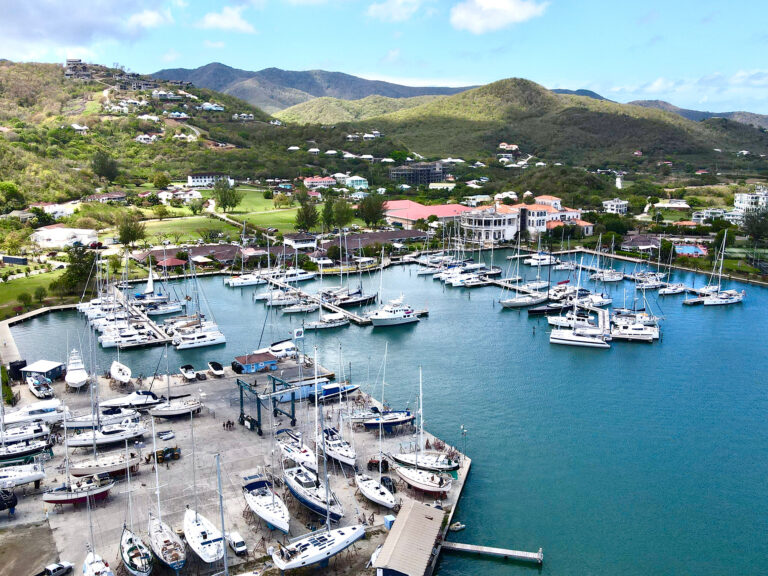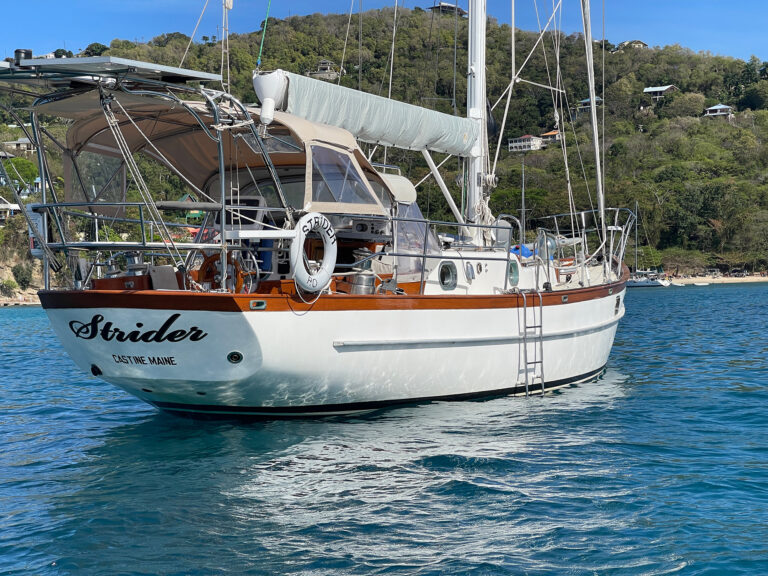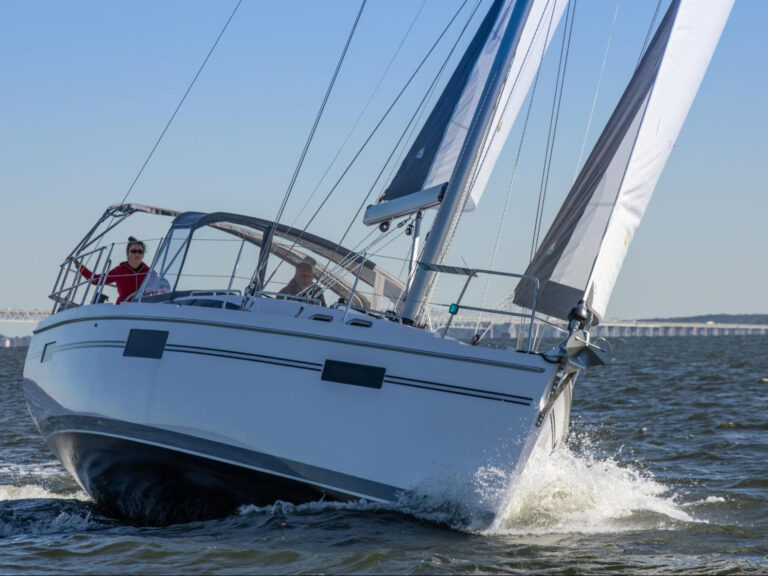
Pactor Babe 368
I’m swimming upward from deep, deep sleep and surface into the reality of my cozy, comfortable forepeak. My eyes snap open. I’m tired, very tired. It’s still dark. My PDA is blinking and beeping insistently. I consider winging it through the open forehatch to hear a satisfying-but expensive-splash. Instead, I sigh and squint to see its screen. “Jim WX, 4 megs” it says. I rest my head back on the pillow and turn to look at Carolyn.
Her dark, Italian hair frames an untroubled face. I look at her for a long time. I owe her. She was 15 years old when I first lured her into my cockpit. Now she’s 55, and far more lovely on every level. I couldn’t have become who I am without her.
“Hey,” I say and walk calloused fingers down an alluringly exposed shoulder. “How’s my Pactor Babe this fine morning?”
“Tired,” she mutters, flops away from me, and snuggles her pillow. “I hate the America’s Cup. Do it yourself.”
Carolyn is my radio officer. We took the exam for our amateur-radio licenses together. At the last moment, Carolyn snatched back her test paper and changed an answer. My score was perfect, 100 percent. She missed one. I happened to “let this slip” a couple of times so all the sailors in the Atlantic, Pacific, and Indian oceans knew. This infuriated her. Thus she continued her radio-theory studies to get additional licenses and, ultimately, to become a volunteer examiner for the Federal Communications Commission.
I didn’t say anything for a long time, but I could tell she was still awake. Finally I whispered, “This takes knowledge, skill and, well, some level of competency and technical expertise-which pretty much eliminates a macho techno-nerd like me. I’m just here to, well, act as a sort of pleasure toy for the crew.”
“OK,” she said resignedly. “You win, Fatty. Do you want a GRS or NOGAP GRIB?”
“Both,” I said, as I thought about the weather brief I’d put together for Jim, “and I wouldn’t mind some NADI text, too.”
“You got it,” she said, and she heaved her lovely self out of the bunk.
The reason we were both tired was because we’d roared ashore in the dinghy at 0200 to a fancy resort on a tiny island called Mala, in the Vava’u Group of Tonga, to watch the America’s Cup, sort of. Actually, it was a live computer simulation of the Cup via the web, which was as close as we could get, technologically, to the action in Valencia. It was fun-but what a horrible groan went up at the bar full of rambunctious Kiwis when Team New Zealand ripped their chute and then hourglassed its replacement during that fifth race.
I’d wisely preset the alarm for early so we could help out our buddy Jim Sublett (see “Alaska Jim,” On Watch, December 2007) and I could still get to writing at my normal time of 0800. The reason I was being so stern with myself was because I’d been assigned a rather difficult article. Normally, I write exactly what I want, and editors can lump it or leave it, but occasionally I’m so greedy that I take formal assignments-and I’d been asked to write a treatise about tribal communications in the Pacific.
Damn, it sounded boring even to me!
But first we had to help out a friend.
Our modest nav/communication station is opposite our small galley aboard our 38-foot sloop, Wild Card, so as I brushed my teeth, I was able to watch Carolyn whirl her radio dials and punch her laptop keyboard.
First, she checked radio propagation via our bundled Airmail software. This allows us to determine, from any spot on earth at any moment, the best frequency to contact any other spot on Earth. Next, she typed in the commands that would let our computer tell someone else’s computer just what it was we were looking for. Then, she fired up our Icom 710 SSB radio along with our German-built Pactor digital modem, roamed for a clear station, and hit “enter” with authority. Soon digital packets of information were whizzing back and forth between our vessel and the Internet via an SSB shore station. Computer windows started popping open. These wind charts, text forecasts, and razor-sharp digital weather charts (known locally as “fleet codes,” a holdover, strangely, from World War II) provided us with an astounding amount of cost-free, location-specific, “almost real time” weather information at our digital fingertips.
“Yeah, that low-pressure system is sliding below us just like you predicted, Fatty,” Carolyn mused as she perused the data. “And the northerly shift has already begun.”
We traded places, and soon, via an SSB voice transmission, I was conveying our morning weather analysis to Alaska Jim on Bell Bird, anchored 100 miles south of us off Ha’afeva, in the Ha’apai Group.
“It looks like you should keep her in the barn for a couple more days until the wind backs into the southeast,” I told him before signing off.
“Roger that, and give Miss Carolyn a hug for me!” he said as he signed off.
Sailors do stuff like this for each other all the time. We all give so we can eventually take. We regularly make deposits in the cosmic Karma Bank of Life. Nobody keeps score but everyone knows the score. Jim doesn’t have a Pactor modem, so I give him the long-distance benefit of mine. I don’t have a watermaker, and so I’m often invited aboard yachts that do-“for cocktails and bring your jugs”-during dry spells. (We catch most of our drinking water but, alas, not all). Basically, what goes around comes around. We all get the reputation we deserve. We sea gypsies are a small but global community. We reap what we sow. I remember one time being anchored in remote, population-less Chagos with 10 other boats in the middle of the Indian Ocean-and there was enough technical expertise present-computer designer, software engineer, outboard mechanic, fishing expert, playwright-to rule the entire world. And the wisdom not to!
Over a leisurely breakfast, Carolyn and I listened in to the infamous “Rag of the Air,” our local southwest-Pacific SSB cruising chat net. It meets every morning on 8173 megahertz at 1900 Zulu. This highly irreverent net is run by another sailor named Jim-Jim Bandy, an American ex-pat who swallowed the hook at Also Island, off Fiji’s north coast, and immediately started his own informal talk show for sailors. The show reaches sailors in an area from Australia and New Zealand in the south to Tonga and Vanuatu in the north.
Basically, all the cruisers within 2,000 miles or so tune in every morning to check the small amount of weather info and large amount of gossip that gets exchanged. The really weird day is Sunday, when “Reverend Jim” seizes the microphone for his traditional 20-minute pseudo-sermon. Some of these homilies are so funny we’re writhing on the cabin sole laughing. Others are decidedly not!
But Jim is a perfect reflection of the global marine community: half crazy, ever willing to help, generous to a fault, and totally “weird as a beard,” as our daughter, Roma, would say.
That day, I tuned into the Rag for a specific reason. A few days previously, I’d chatted with a happy-go-lucky Texan named Louis Honeycutt, who sails Elysium, a 44-foot Cross-designed trimaran that was built in 1968. He was headed for Port Resolution, on the island of Tanna, in Vanuatu, a cruising destination Carolyn and I dearly love. We immediately told him how much we’d enjoyed our stay there (see “Tall Tales from the South Pacific,” October 2007) and wished him luck. Unfortunately, the following day Louis reported that his recently repaired prop shaft had slipped aft of its coupling and the boat had nearly sunk before he’d been able to staunch the water flow. He was engineless, much of his electronics were down, and he was now diverting to a harbor that would be easier to enter under sail. He didn’t sound happy anymore.
Worse yet, the following day he didn’t come up on the Rag, which was ominous.
On this morning, we hoped to hear that Louis and his three crewmembers aboard Elysium were in safe harbor and resting before attempting repairs. Instead, our friend Russ Cobb (KK4MT) on Hygelig surfaced on the frequency. Russ is an avid ‘ham’ who is active on all bands. He often acts as a liaison between different nets, such as the very formal Pacific Seafarers net (14300, on 20 meters) and the laidback Rag.
“PacSea is reporting the 406 EPIRB registered to Elysium went off last night, right in our area. I mean, we know Louis had trouble, he isn’t responding, and now his EPIRB has been activated. I think we should take this one seriously, guys!”
Immediately, all chatter ceased on the Rag. This is, after all, primarily why such cruising nets exist: to help. Suddenly dozens of people in dozens of countries-separated by a half-million-square-miles of ocean-pooled their communication resources to help a fellow mariner in (at least potential) distress.
Jim Bandy, as net control, repeated Elysium’s last reported position, and announced he’d act as Information Central. Vessels in Port Resolution confirmed that Elysium hadn’t arrived. Various SSB volunteers were dispatched to other marine nets on different frequencies to spread the word as accurately as possible, and to relay any pertinent info back to the Rag. To facilitate this, it was agreed to meet back on the same frequency in four hours, and four hours after that if needed.
Various people were able to help in different ways because of their specific technology. For instance, Randy Schneider, an American sailing a Gozzard 44, Procyon, used his satellite phone to contact the U.S. Coast Guard in both Hawai’i and San Diego. Ditto Captain Steve aboard Aussie Oi, who communicated with the Australian coast guard in Sydney. A passing New Zealand yacht within VHF-radio range of New Caledonia (which is the search-and-rescue base in this area) immediately brought the French up to speed on the situation. Other boaters contacted Louis’ stateside family and confirmed and expanded our known details. E-mails flew hither and yon. Carolyn queried Winlink (see “On the World’s Airways, Amateurs Find a Niche,” page 71) to see how many boats with active ham radios were currently in the potential search area. (This technology to precisely locate a seagoing ham is so new that it’s rarely used, but it’s highly valuable in SAR situations. Basically, we can always find out which of the boats around us equipped with ham radios are issuing position reports).
That morning, there had been two ongoing incidents that the net had been following with interest; both were temporarily put on hold. The first was a northbound catamaran named Holokai, with Spike and Angela aboard, that was bound for Savusavu, in Fiji. It had broken its boom and ripped its mainsail during a welcome-to-the-tropics gale. Rick Walker on the catamaran Endangered Species volunteered to act as mission control on this non-life-threatening incident, taking the vessel’s skipper off frequency to continue to closely monitor his condition without interfering with the main event. Another vessel was heading east from New Zealand in the distant South Pacific Ocean; the skipper had taken an unplanned swim. My old Virgin Islands multihull friend Ted “Wood-Butcher” Cary, on the much-modified Jim Brown trimaran Seaquester, decided to play good shepherd on this one.
Frequency-band conditions changed throughout the day, of course, as is common with SSB and ham radios. This required frequency changes and lots of relays, where one yacht passes the “baton of information” onward to another, and thus vast miles of ocean are covered in seconds. Think of it as repeating smoke signals from mountaintop to mountaintop.
Yes, the modern world of marine communications is a truly wondrous thing. I never thought that a modest vessel like Wild Card, with our tiny cruising pocketbook, would be in almost continuous e-mail and radio contact with the rest of the world. Or that I’d be able to exchange text, pictures, software, MP3s, and graphics with other distant vessels, completely free of charge, thanks to our Pactor modem and free Easy Transfer software.
Wasn’t it only yesterday that a whaler would convey news of a death aboard by painting a blue stripe around his vessel? Or fly a long red ‘homeward bound’ pennant to signal his willingness to carry mail home? Why, a whaler’s wife might be reading today’s letter within the year!
If all this radio “busy-ness” wasn’t enough, we also listened to the Pacific Report from distant Radio New Zealand for its comprehensive roundup of local Tonga/Fiji/Samoa news. Simultaneously-at one point, Carolyn and I had on three radios at the same time-we checked into our local VHF Vava’u cruisers net on Channel 06 during its Treasures of the Bilge segment, hoping to trade our heavy 17-foot-six-inch whisker pole for a lighter 14-footer; it’s something we’ve been trying to do for, oh, five or six years now.
Mostly, while waiting for news of Elysium, we thought back on dozens of other “SSB rescues” we’d been involved with over the years. (Log on to www.cruisingworld.com/0308seastories to read more rescue tales from Fatty.)
Our SSB suddenly exploded with activity: Four sailors had swum ashore on a small island, Futuna, which lies just east of Tanna. It was officially confirmed: They’d been sighted on the beach by a French SAR plane. One crewmember was reported to have severe coral cuts, but the others were basically OK-rather shaken from their ordeal, sure, but OK. The boat, alas, was a total loss.
Carolyn and I didn’t talk about it. Not then. It was too early. All the facts weren’t in. And we hadn’t processed it mentally. We’ve spent our whole watery lives a tack or two from catastrophe, and we don’t relish hearing such hard-luck news about other sailors. Instead, we shut off the cabin lights and crawled into our bunk.
I was dead-dog tired. Hell, I’d communicated with half the world even if I hadn’t gotten off the boat. My mind was spinning. I could tell Carolyn was awake, too: after 38 years in the same small, toe-touching V-berth, our sleepy consciousnesses have almost melded.
“You never got to your writing today,” she mused quietly into her pillow.
“Mañana’s fine,” I yawed. “No problem.”
“What’s the writing assignment about?”
“Tribal communications,” I said. “How certain groups of nomadic Pacific residents-specifically, we far-flung sea gypsies-communicate.”
“So today you lived it,” she began. And I concluded, “And tomorrow I’ll write it.”
Neither of us said anything for a while. The tropical-night air felt delicious on our naked skin. There were a million/billion stars crowding the open forehatch above. Tiny waves lullabied our hull. Finally I whispered, “And how’s my Pactor Babe?”
“Needy,” she said.
Aboard Wild Card, Carolyn and Cap’n Fatty are sailing-and chatting-their way through Micronesia.







